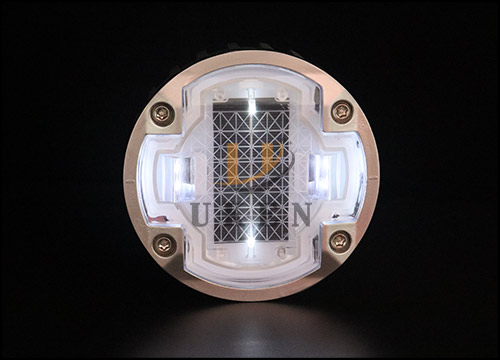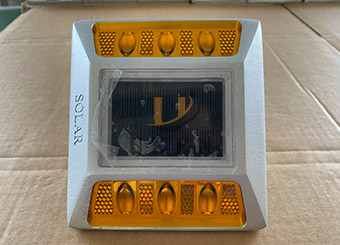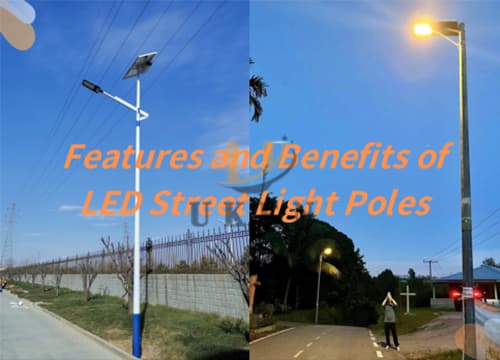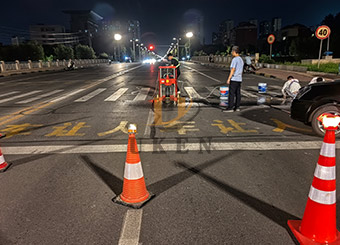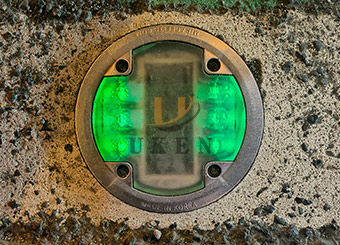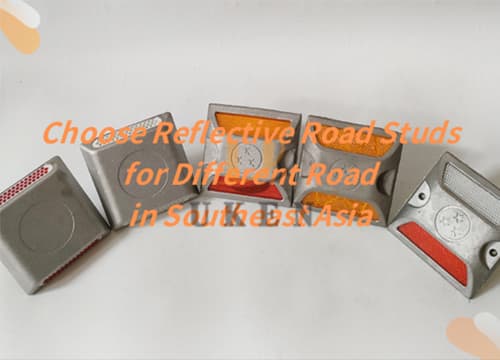As a key component of intelligent transport facilities, solar road studs play a crucial role in enhancing road safety, guiding traffic flow and enhancing visibility in low-light or adverse weather conditions. Whether they are used to warn of bends on motorways, separate lanes on urban roads or guide country lanes at night, they provide clear path markings for drivers and pedestrians through reflective or active light-emitting features. However, understanding their lifespan not only helps buyers to make informed purchasing decisions, but also helps users to plan their maintenance intervals and costs to ensure that the studs continue to perform.
Extreme temperatures, heavy rain, snowstorms and ultraviolet radiation are the main environmental threats affecting the life of the solar stud. High temperatures may lead to softening and deformation of the stud’s shell material, while low temperatures reduce battery activity and affect energy storage efficiency. For example, plastic housings can become discoloured and brittle in areas where surface temperatures exceed 60°C in the summer, while lead-acid batteries can lose more than 30% of their capacity in cold areas where temperatures are -20°C in the winter. When exposed to rain for a long time, if the waterproof sealing of the studs fails, it may lead to short circuit of the internal circuit; strong ultraviolet rays will accelerate the aging of the coating on the surface of the solar panels, which will reduce the efficiency of photovoltaic conversion.
Road surface roughness, traffic flow and vehicle load directly affect the mechanical life of the stud. In the frequent passage of heavy trucks in the logistics channel, the number of times a year, the road stud can withstand hundreds of thousands of times of crushing, which may lead to internal weld fracture or shell rupture. In the pothole uneven road surface, the stud due to long-term vibration is prone to loose parts, such as LED beads fall off or battery cable wear.
The life of the solar panel directly determines the energy supply capacity of the stud. High-quality monocrystalline silicon solar panel service life of up to 20-25 years, its photoelectric conversion efficiency of more than 20%, and excellent impact resistance (can withstand 24mm hail impact). On the other hand, low-cost polycrystalline or amorphous silicon panels may fail after 5-8 years due to a decay rate of more than 30%, with a conversion efficiency of less than 15%, and are fragile and vulnerable.
Lead-acid batteries: Commonly used in economic studs, with an average lifespan of 3-5 years, they require regular maintenance of the electrolyte level, or else their capacity will drop suddenly due to the phenomenon of sulphation. In the high temperature environment, its self-discharge rate of up to 30% per month, accelerated aging.
Lithium-ion battery: 5-10 years of service life, energy density is 2-3 times that of lead-acid batteries, support fast charging and better low-temperature performance (-20 ℃ can still maintain 80% capacity), but the cost is higher, and need to be matched with a BMS battery management system to prevent overcharge and overdischarge.
The life span of LED lamps is mainly measured by light decay. High-quality LED lamps can still maintain more than 70% of their initial luminous flux after 50,000 hours, whereas poor-quality products may lose half of their brightness or die within 20,000 hours. Heat dissipation design is a key factor affecting the life of LEDs. Aluminium heat dissipation housings can keep the junction temperature below 60°C, extending the life of the lamp beads.
stud housing needs to take into account the lightweight and high strength. The use of PC/ABS alloy + 30% glass fiber shell, compressive strength of up to 20 tons or more, salt spray corrosion resistance (1000 hours of testing without rust), while the ordinary plastic shell is easy to crack after a long period of time after crushing, waterproof grade (IP68) may fail.
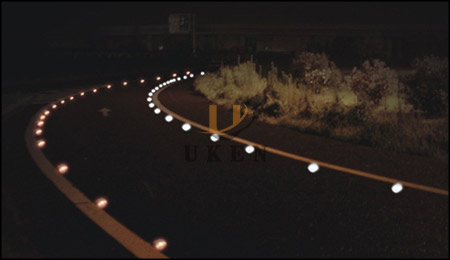
Regular maintenance can extend the life of the stud by 20-30%. For example, monthly cleaning of solar panels can improve charging efficiency by 15%, and quarterly checking of battery voltage can detect capacity decay problems in time. On the other hand, neglecting maintenance can lead to dust covering the solar panels and triggering the hot spot effect, or long-term over-discharge of the battery causing irreversible damage. In addition, high-frequency flashing light (e.g., more than 60 flashes per minute) will accelerate the loss of LEDs and batteries, and it is recommended that the flashing frequency be adjusted according to the traffic flow.
Solar panel
Mainstream monocrystalline silicon solar panels have a lifespan of 20-25 years, but the average annual attenuation rate is about 0.5%-1% due to the environmental impact in actual use. For example, a solar panel with an initial power of 5W may be reduced to 4-4.5W after 10 years, but it can still meet basic lighting needs. If it is hit by hard objects or severe hot spots, its life may be shortened to 10-15 years.
Batteries
Lead-acid battery: the cycle life is about 300-500 times, calculated by charging and discharging once a day, the theoretical life is 1-1.5 years, but in practice, due to the difference in maintenance, it can be 3-5 years.
Lithium-ion battery: cycle life of 800-1200 times, life expectancy of about 5-10 years, lithium iron phosphate type can reach more than 1500 times, suitable for high-frequency use of the scene.
LED light
Calculated on the basis of 12 hours of work per day, the life expectancy of 50,000 hours is equivalent to about 11.5 years, and 100,000 hours is up to 23 years. In practice, due to good heat dissipation and stable operating voltage, most LED lamps can be used for 8-10 years without significant light decay.
Overall Lifespan
The overall design life of a solar stud is usually 5-10 years, taking into account the life of each component. In the ideal environment (low traffic, mild climate, regular maintenance), high-quality products last up to 10-12 years; in harsh environments (high loads, extreme climate, zero maintenance), the life may be shortened to 3-5 years.
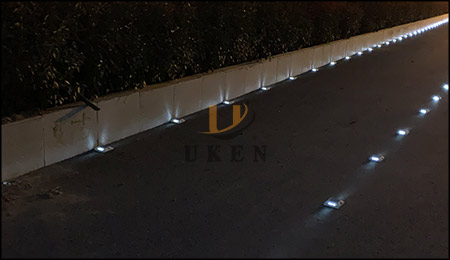
Quality Selection
Give priority to products that have passed CE, RoHS and IP68 certifications, such as studs equipped with A-grade solar panels, automotive-grade lithium-ion batteries and aerospace aluminium housings. Refer to third-party test reports to compare the performance of different brands in salt spray, vibration, and high and low temperature cycle tests, and avoid purchasing ‘three-nos’ low-priced products.
Standardised Installation
Ensure that the road surface is flat and clean before installation, and use high-strength structural adhesive (e.g. epoxy resin) to fix the road stud to avoid stress concentration caused by voids. Use waterproof terminals when wiring to prevent rainwater infiltration. In heavy load areas such as motorways, it is recommended to embed 2-3cm into the road surface to reduce direct impact.
Regular Maintenance
Monthly maintenance: Wipe the solar panel with a soft cloth, remove bird droppings and dust, and check the shell for cracks;
Quarterly maintenance: use multimeter to check the battery voltage (lead-acid ≥12V, lithium ≥3.6V), clean up the oil on the surface of LED lens;
Annual maintenance: dismantle the studs to check the internal lines, replace the aging seals, and test the efficiency of charging and discharging cycles.
Component Upgrade
When the battery capacity drops below 60% of the initial value, replace it with lithium-ion battery of the same specification in time; if there is a large area of dead LED lights, replace the light board as a whole. Some brands support modular design, no need to replace the whole stud can upgrade components, reduce maintenance costs.
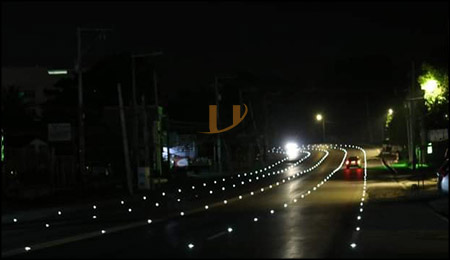
Initial investment and long-term cost
Calculated on a 10-year cycle, the unit price of 100 yuan of economic studs (life expectancy of 5 years) need to be replaced twice, the total cost of 300 yuan; while the unit price of 180 yuan of high-quality studs (life expectancy of 10 years) the total cost of only 180 yuan, a savings of 40% of the cost. In addition, the average annual maintenance cost of high-quality studs is about $10, which is lower than the average annual cost of $30 for economical studs.
Return on Investment (ROI)
Extending the life of road studs can significantly reduce the traffic accident rate. According to statistics, in the curved areas where high-quality solar road studs are installed, the nighttime accident rate drops by 65%, and the savings in insurance claims and rescue costs can raise the ROI to 200%-300%. In addition, reduced replacement frequency means lower labour and traffic control costs, which is particularly suitable for large-scale road projects.
The lifespan of solar road studs is affected by multiple factors such as environment, component quality, maintenance level, etc. The lifespan of each component varies significantly, and the overall design lifespan is usually 5-10 years. By choosing high-quality products, standardised installation and regular maintenance, its service life can be effectively extended and its cost-effectiveness enhanced.
Users are recommended to prioritise the warranty period of modules (e.g. 10-year warranty for solar panels and 5-year warranty for batteries) when purchasing, and to set up maintenance files to record each maintenance. For high-traffic roads or important areas, upgrade to smart studs with remote monitoring to monitor the lifespan status in real time and provide early warning of the risk of module aging. For further product details or to obtain a maintenance plan, please contact our technical team.
